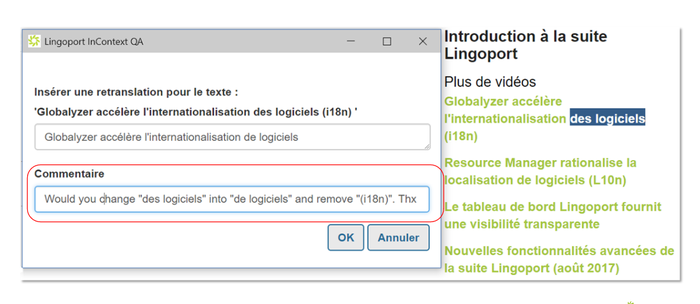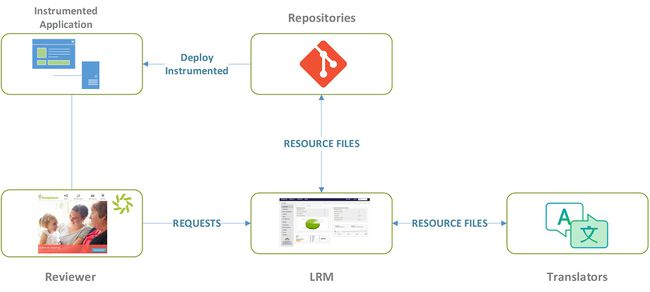Difference between revisions of "About InContext QA"
(Created page with "= High Level Goals = The Lingoport InContext QA goals are: * Facilitate the translation review process of internationalized applications * Provide a simple way to review and e...") |
|||
| (28 intermediate revisions by 2 users not shown) | |||
| Line 1: | Line 1: | ||
| + | InContext QA allows the linguistic reviewer to select a translated string in an instrumented application, suggest a new value, and submit the change to Localyzer. |
||
| + | |||
| + | [[File: InContextQA.png |700px]] |
||
| + | |||
| + | In this example, a reviewer found that the French translation ("des logiciels") was incorrect. The string was highlighted and a new string was suggested and a comment given. |
||
| + | |||
= High Level Goals = |
= High Level Goals = |
||
| − | The Lingoport InContext QA goals are: |
+ | The Lingoport '''InContext QA''' goals are: |
* Facilitate the translation review process of internationalized applications |
* Facilitate the translation review process of internationalized applications |
||
* Provide a simple way to review and edit translations of an application’s string resources in Chrome |
* Provide a simple way to review and edit translations of an application’s string resources in Chrome |
||
| + | * Simplify the Linguistic QA of a Web application |
||
The following is not a goal of Lingoport InContext QA: |
The following is not a goal of Lingoport InContext QA: |
||
| − | * Lingoport InContext QA does not replace how translation is done: It is not a TMS and not pretending to be one. |
+ | * Lingoport InContext QA does '''not''' replace how translation is done: It is not a translation management system (TMS) and not pretending to be one. |
| + | |||
| + | = Benefits = |
||
| + | * Strings to review are displayed in their context. They are on a live Web-based application so reviewers can see strings in the context they are presented. |
||
| + | * There is no software developer involvement, freeing up developers from the localization process. |
||
| + | * Easy, direct interaction from reviewer to localization group. |
||
| + | * Automatic updates |
||
| + | * Light, minimal learning curve for reviewers. |
||
| + | * Non-intrusive, no changes to the code and web apps can be deployed while being reviewed. |
||
| + | |||
| + | = System Overview = |
||
| + | |||
| + | [[File:InContext QA System Overview.jpg|650px]] |
||
| + | |||
| + | For an on-boarded repository, the happy path looks like: |
||
| + | * Resource files are analyzed by Localyzer and displayed in the Dashboard |
||
| + | * Resource files which need to be translated are sent to the Translation Group |
||
| + | * Translated resource files are received by Localyzer and pushed to the repo |
||
| + | * Translated resource files are instrumented |
||
| + | * The application with instrumented resource files is deployed to a Linguistic QA server |
||
| + | * The reviewers navigate to the deployed instrumented application |
||
| + | * The reviewers submit suggestions which are captured by Localyzer |
||
| + | * Localyzer handles the retranslation requests and deals with the bookkeeping, the automation, the metrics, etc. |
||
Latest revision as of 20:33, 23 February 2021
InContext QA allows the linguistic reviewer to select a translated string in an instrumented application, suggest a new value, and submit the change to Localyzer.
In this example, a reviewer found that the French translation ("des logiciels") was incorrect. The string was highlighted and a new string was suggested and a comment given.
High Level Goals
The Lingoport InContext QA goals are:
- Facilitate the translation review process of internationalized applications
- Provide a simple way to review and edit translations of an application’s string resources in Chrome
- Simplify the Linguistic QA of a Web application
The following is not a goal of Lingoport InContext QA:
- Lingoport InContext QA does not replace how translation is done: It is not a translation management system (TMS) and not pretending to be one.
Benefits
- Strings to review are displayed in their context. They are on a live Web-based application so reviewers can see strings in the context they are presented.
- There is no software developer involvement, freeing up developers from the localization process.
- Easy, direct interaction from reviewer to localization group.
- Automatic updates
- Light, minimal learning curve for reviewers.
- Non-intrusive, no changes to the code and web apps can be deployed while being reviewed.
System Overview
For an on-boarded repository, the happy path looks like:
- Resource files are analyzed by Localyzer and displayed in the Dashboard
- Resource files which need to be translated are sent to the Translation Group
- Translated resource files are received by Localyzer and pushed to the repo
- Translated resource files are instrumented
- The application with instrumented resource files is deployed to a Linguistic QA server
- The reviewers navigate to the deployed instrumented application
- The reviewers submit suggestions which are captured by Localyzer
- Localyzer handles the retranslation requests and deals with the bookkeeping, the automation, the metrics, etc.

